Are you struggling to determine whether you’re setting the right project goals for your team? Are you unsure whether you’re asking them for too much or too little? If your answer is yes, you’re not alone.
At the core of any project lie its project goals, as they define its purpose and expected outcome. It’s often the role of company leadership to set and assign project management goals to project managers, usually with ambitious targets in mind.
However, many organizations find it challenging to balance ambition with practicality when it comes to project goal setting. Set your targets too high, and you might end up with frustrated team members, or worse, burnout. Set your sights too low, and you risk subpar results, loss of productivity, a dwindling customer base, and a team that’s demotivated and complacent.
The key lies in understanding how project goals work and how the various elements involved affect goal setting. This article will help you achieve just that.
We’re going to look at project goal setting and writing in detail. In addition, we’ll go over some examples of realistic goals to help you get started.
What are project goals?
Project goals are high-level descriptions of a project’s desired outcome. They provide teams with a direction and purpose to work towards. They also give project managers a way to measure the results achieved.
A project can have several types of goals, including:
Scope
The project scope describes in detail what has to be delivered. It documents the project’s deliverables and breaks them down into smaller pieces. That’s called a work breakdown structure (WBS). The lowest level of the WBS can be assigned as tasks. The project manager can assign resources to complete those tasks. And the team can define procedures for how the completed work will be verified.
Quality
Quality goals ensure the desired outcome of a project meets predefined and agreed-upon quality standards. Typically, these standards are based on stakeholder expectations. Quality goals provide benchmarks for project evaluation and can identify areas of improvement.
Time
Time-based goals establish the critical milestones and deadlines that a project team needs to achieve to keep the project on track. These goals help teams organize themselves, help them focus, and prioritize tasks.
Performance
Performance goals define the efficiency and performance levels required to complete project activities. They focus on factors such as timeliness, resource utilization, and punctuality.
Cost
Cost goals outline the project budget constraints. They help project teams draw boundaries around project expenditures and innovate to meet cost-efficiency targets. Cost goals guide a project team’s spending priorities and play an essential role in the financial success of a project.
What is the difference between project goals and project objectives?
The words “goals” and “objectives” may be used interchangeably in common language. However, in the context of project management, it’s important to understand how they’re distinct from each other.
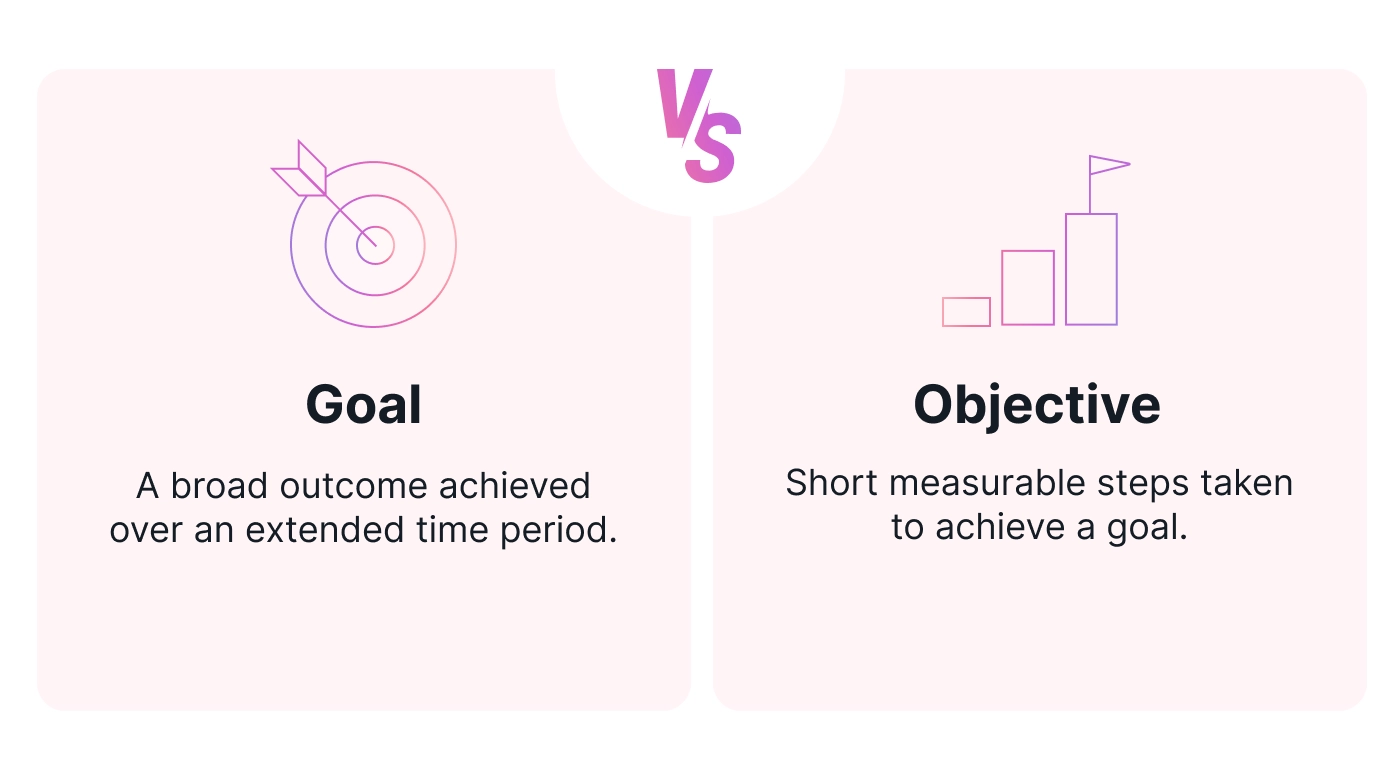 |
Project goals
A project goal is a description of what a project is supposed to achieve. It typically specifies the focus area of the project and describes the expected outcome within a given time frame.
Project goals are usually broad and strategic. They do not go into the specifics of a project, nor do they provide details on how the desired outcome will be achieved.
Project objectives
Project objectives provide the details and specifics of how a project goal is going to be accomplished. They’re measurable outcomes that form the building blocks of a project goal.
Project objectives are tactical. The completion of each objective makes a quantifiable contribution towards the achievement of a project goal. A single project goal can have multiple objectives that tell the project team exactly what to achieve in the short term to reach the goal in the long term.
The importance of setting challenging yet practical project goals
Setting achievable goals in the context of a project’s requirements is critical to project success. The importance of project goals is underscored by the fact that 37% of executive leaders believe a lack of clear goals is the most common reason why projects fail.
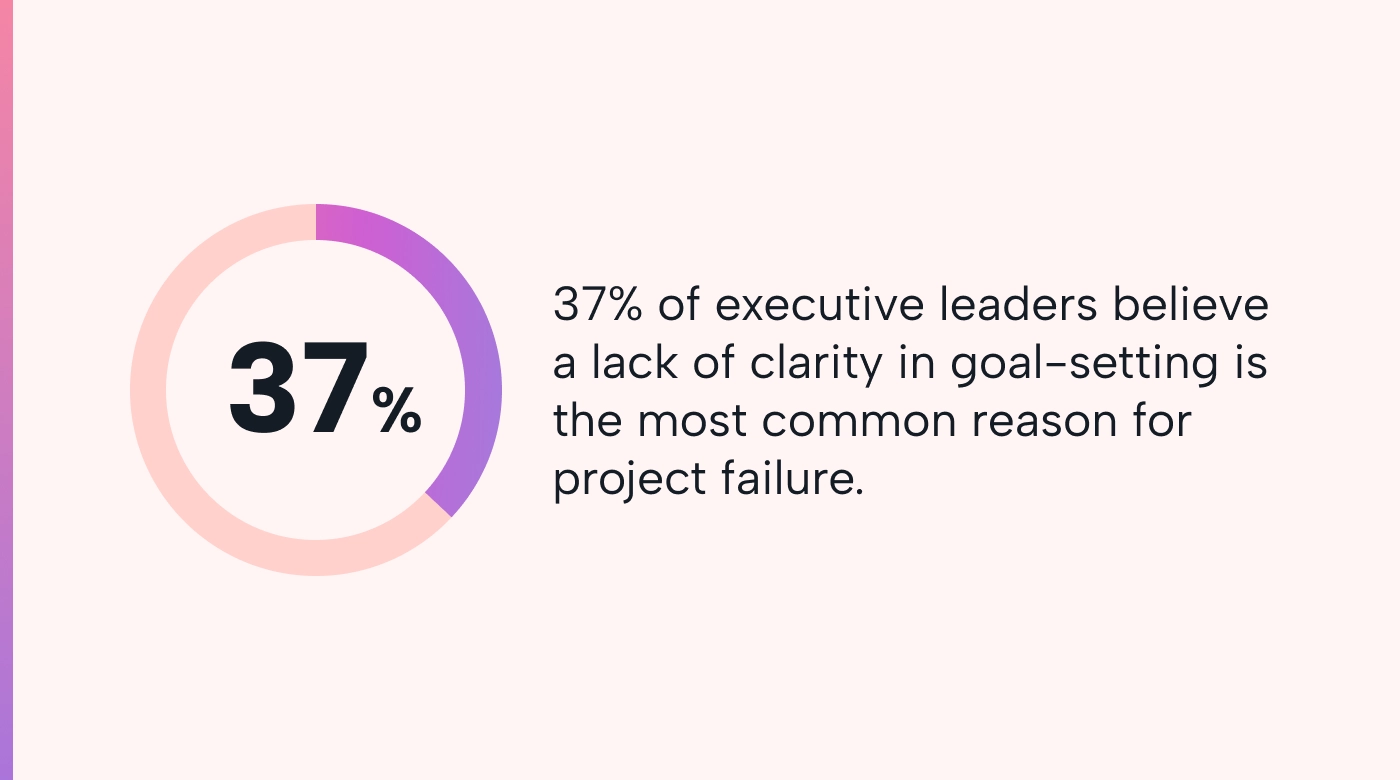 |
Here are some of the ways project milestones and goals support a project.
Provide clarity
Organizational goals offer a clear understanding of what the company is trying to achieve through the project. Ideally, goals document a project’s desired outcome in clear language so there’s alignment among all the project stakeholders involved.
Drive team focus
Achievable goals help teams collaborate and focus their efforts to achieve the desired outcome. Without a common goal to work towards, it’s hard for a team to work together. Project goals provide a clear direction to help teams organize, prioritize, and build synergies.
Awareness of effort required
Project management goals help project managers determine the amount of work required and manage resources accordingly. Think of a project with no clear goals. How would a project manager know what to prioritize or deploy resources toward?
With a clear understanding of a project’s goals, project managers can make critical decisions on factors such as the required amount of resources (human and otherwise), time, and cost.
Increased motivation to act
Realistic goals promote accountability and provide measurable targets for the team to hit. This gives each team member a clear understanding of where they belong in the big picture, making their work more meaningful and boosting motivation.
Behavior optimization
Strategic goals allow project managers to understand the kind of behavioral optimization necessary to achieve the desired outcomes. This can involve activities such as training team members for their tasks, adjusting schedules, and modifying roles to meet project requirements.
Alignment with company goals
Project goals can help team members figure out how a project contributes to achieving company goals. Analyzing goals vis-a-vis company goals also provides a litmus test to determine whether or not a project belongs in a company’s portfolio.
Improve team confidence
Achieving project management goals and objectives builds team confidence and instills self-belief in team members. This sense of accomplishment builds momentum that experienced teams can carry into their next project.
How to set project goals
Here’s a structured approach to setting ambitious yet practical project goals.
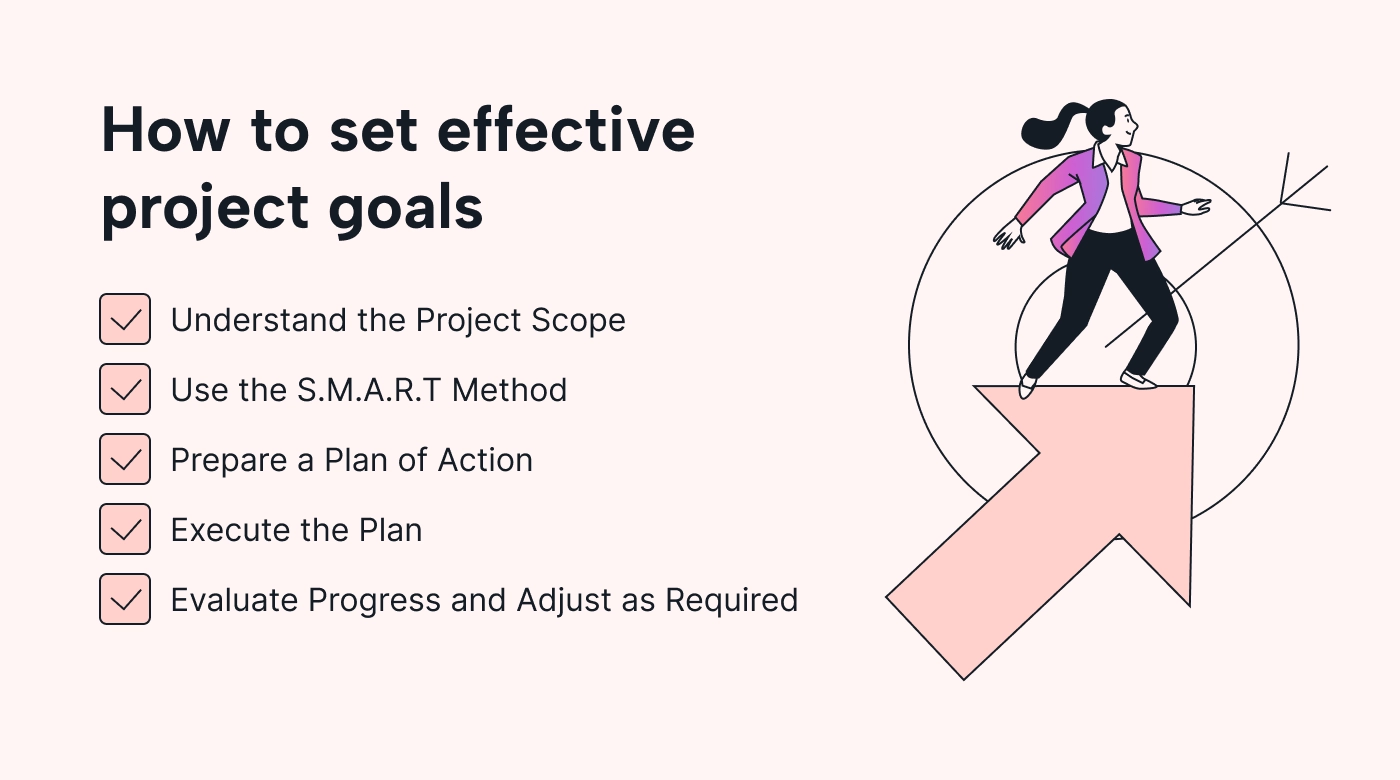 |
Understand the project scope
To begin with, you need to document exactly what you want to achieve and how you’d like to go about it. This is where the project scope comes in. Establishing the project scope is the first and one of the most critical steps in the project goal-setting exercise.
The process involves:
- Documenting the deliverables and requirements.
- Breaking them down into a work breakdown structure.
- Establishing boundaries around the expected outcome.
- Assigning responsibilities.
- Determining a way to measure the outcome.
Understanding a project scope allows all the key stakeholders to align on the relevant deliverables, constraints, and assumptions of the project.
Use the S.M.A.R.T method
SMART is an acronym for Specific, Measurable, Achievable, Realistic, and Time-bound. Once the project goals are identified, use the SMART framework to define project objectives.
After defining a broader goal, SMART goal objectives outline quantifiable and measurable steps that form the building blocks of a goal.
Using the SMART method, you can remove ambiguity from your project plan, give your team specific targets to hit, and learn about potential areas of improvement as you evaluate the outcome.
Prepare a plan of action
Once you’re clear on your project goals and objectives, it’s time to decide how to set things into motion with all the moving parts and resources at your disposal. Your plan of action is going to provide details on how you’re going to execute each of the required tasks.
The plan covers specifics on:
- The team members.
- Their roles.
- Actions required to achieve the project objectives.
- The timelines for each deliverable.
Execute the plan
During execution, project managers lead their team members through the processes that were just planned. This involves arranging regular check-ins with team members to assess their progress and be sure they have the resources they need to fulfill their responsibilities.
The project manager needs to ensure the project team has the required support system and approvals to execute their tasks.
Evaluate progress and adjust as required
This stage involves monitoring project execution, ensuring everything’s on track, and making adjustments where required.
As a result of continuous monitoring and evaluation, the project manager may have to make necessary adjustments to ensure the team achieves its objectives.
Reassigning tasks, changing timelines, or replacing team members are all examples of the kind of adjustments a manager might have to make during the evaluation stage.
Examples of project goals
Here are some examples that can help to understand project management goals and the objectives that can be derived from them.
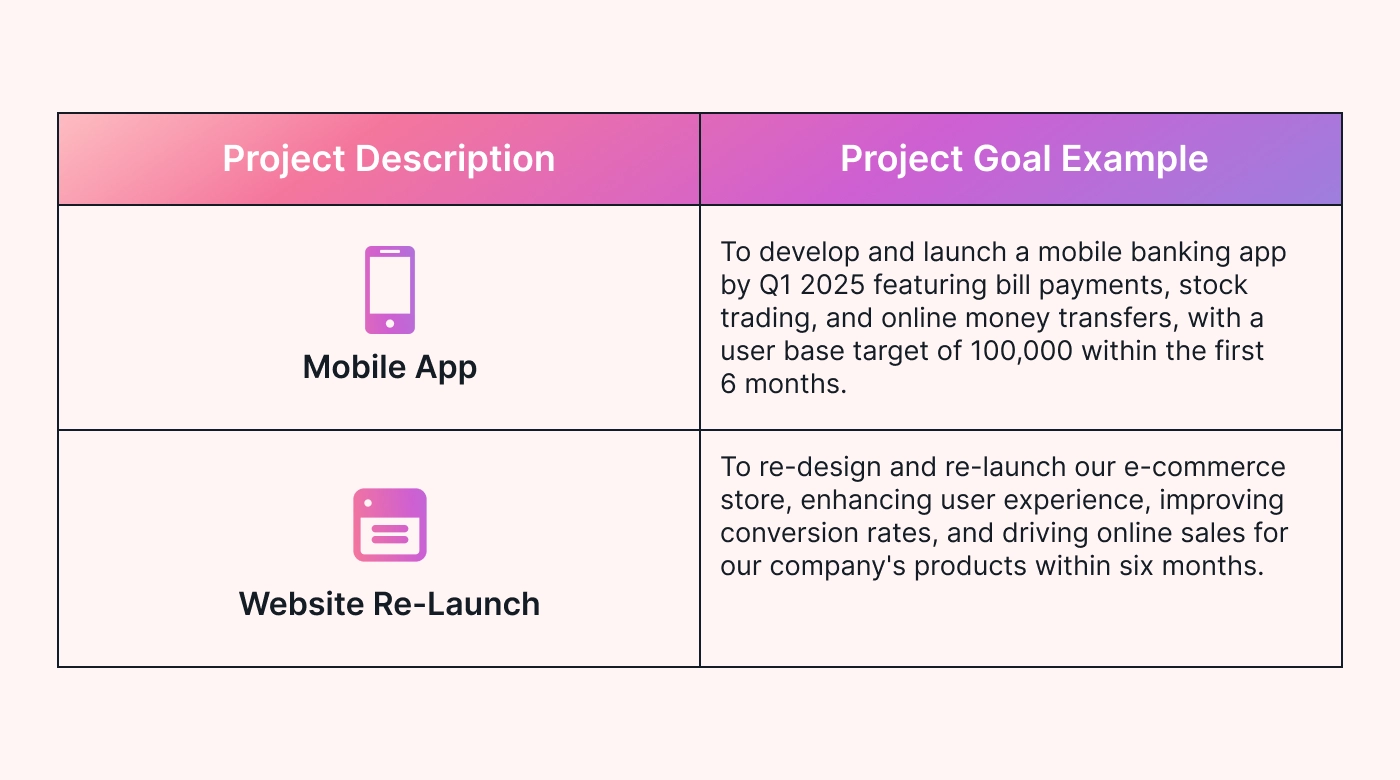 |
Examples of project objectives
Here’s an example of how project objectives form the building blocks of a project goal.
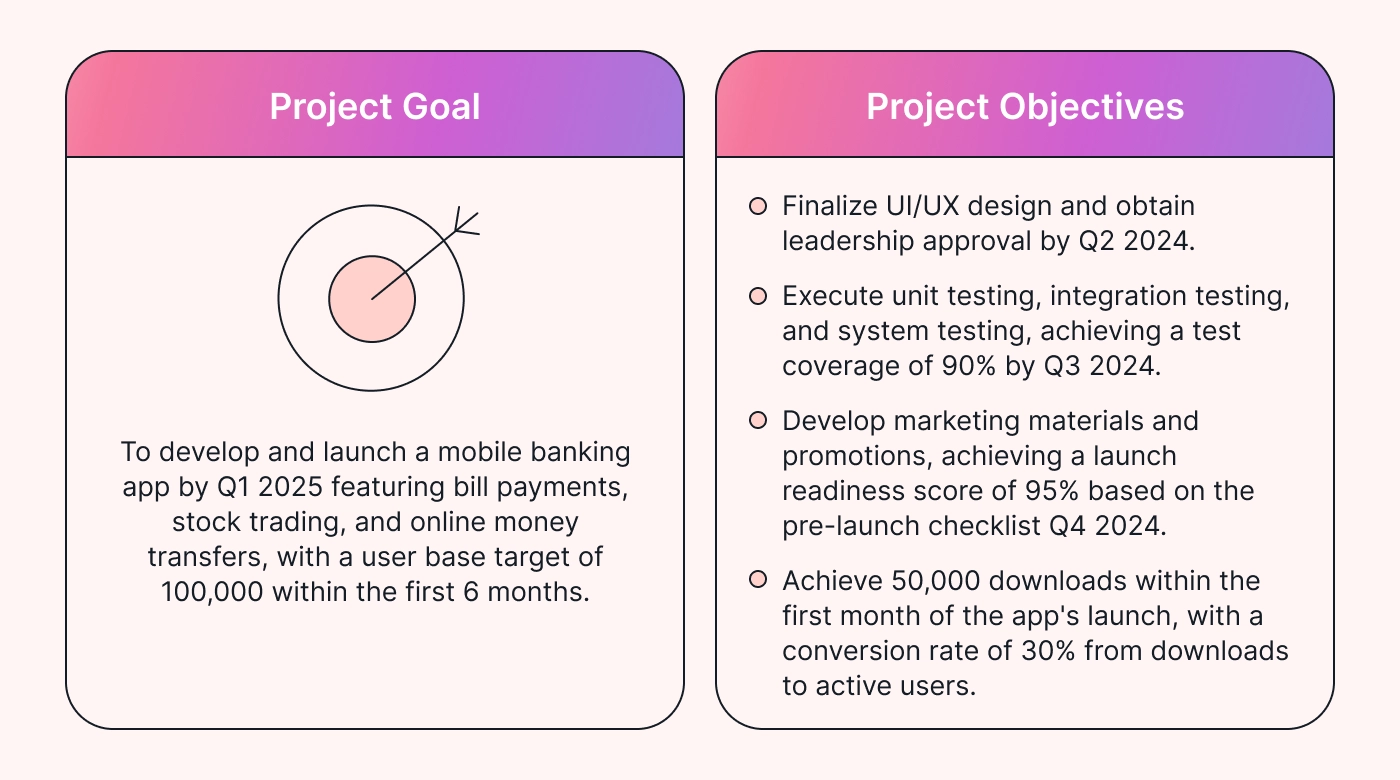 |
How to write project goals
Now that we’ve discussed the framework for setting effective project goals let’s review a few tips for writing them down.
 |
- Start by documenting the description of your project goal in clear language. This description should be the result of detailed consultation and collaboration with all the stakeholders and your team members.
- Define project objectives for the goal. Write down the detailed steps and activities you must execute to achieve the project goal. Remember to use the SMART format.
- Establish a project timeline. Without a timeline, a goal is just a wish. Consider factors such as project scope, resources, and constraints to identify the project's start and end date. The scope and available resources will help you prioritize activities and develop a timeline.
Examples of ambitious project goals
Here’s what ambitious yet achievable project goals can look like:
- Renewable Energy Project: By Q4 2026, reduce the company’s reliance on fossil fuels by 50% and replace it with renewable energy through the development of wind and solar power facilities.
- Ed-Tech Project: Launch an AI-based mobile app by the end of Q3 2025 that provides personalized learning experiences for high school students of organic chemistry and improve their average scores by 25% by Q3 2026.
- Community Health Project: Reduce the incidence of diabetes by 30% in the targeted urban area by Q1 2026 by implementing a community-wide wellness program that will include free health screenings and establishing nine fitness centers.
How can Motion help with project planning?
Motion is your automatic project manager, calendar, meeting scheduler, task manager, and more. It’s powered by a one-of-a-kind intelligent algorithm focused on maximizing your happiness (well, at least your accomplishments) while boosting your productivity.
Usage analytics and client feedback indicate that Motion can save you an average of two hours per day and boost your productivity by as much as 137%.
Motion allows you and your team to focus on executing your project goals and objectives by doing the heavy lifting of project management for you, such as serving up tasks and other work to you and your team in accordance with available work time, priorities, deadlines, and dependencies. And by tracking reported progress for you, and adjusting calendars in accordance with new and perhaps urgent tasks that might come up.
Here’s a quick look at some of its salient features:
- Integrates with your Google, Microsoft, and iCloud calendars and streamlines task scheduling, reducing manual effort. Motion keeps you focused.
- The app’s project management system helps you execute your projects efficiently by helping you set deadlines and dependencies, assign responsibilities, and monitor progress.
- Makes the schedule for you and your team without ever over-allocating time. Simply add your tasks, define priorities, and let Motion’s AI algorithms take care of your calendar.
- Schedules tasks automatically based on dependencies, deadlines, priorities, and available work time.
- Includes attachments you want for events and meeting invites for more context.
- Creates tasks from your voice commands to Siri on your iPhone.
 |
Use Motion to achieve your project goals
Setting project goals that are challenging yet realistic can help individuals and organizations achieve remarkable results. Having the right mix of ambition and practicality in your project goals can boost your team’s motivation, focus, and confidence.
To define the right project goals, you need to first understand the scope of the project. When writing goals down, establish clear timelines and break the project goals down into specific objectives using the SMART approach.
Your goals support the planning and execution of your project. To optimize for better future performance, evaluate your progress and make adjustments as needed.
Use a project management tool like Motion to take your project management function to the next level with the help of AI. Motion boosts your focus and efficiency by optimizing your schedule and task lists. Start your 7-day trial with Motion.

As a freelance B2B SaaS writing for companies like Prerender.io, BenchmarkEmail, SecoMapp, DOCUDavit, and more, my approach to creating quality content begins with robust research and hard data.




